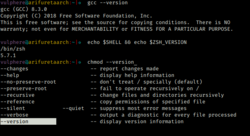Z shell
| Z shell
|
|
|---|---|
 Example of a Z-Shell session |
|
| Basic data
|
|
| developer | Peter Stephenson and others |
| Publishing year | 1990 |
| Current version |
5.8.0 ( February 15, 2020 ) |
| operating system | various |
| programming language | C. |
| category | Unix shell |
| License | BSD-style license |
| zsh.org | |
The Z shell ( zsh ) is a Unix shell that can be used both as an interactive login shell and as a powerful command line interpreter for shell scripts . The zsh is often seen as an extended Bourne shell that combines many improvements and features from bash , ksh and tcsh .
The Z shell has been the default shell in Apple's macOS operating system since macOS Catalina .
origin
The first version was written in 1990 by Paul Falstad, then a student at Princeton University .
Origin of name
The name zsh is derived from Zhong Shao, professor at Yale University , who was an assistant at Princeton University at the time. Paul Falstad thought that Shao's login name "zsh" was a good name for a shell.
properties
- Programmable command line extension for both options and arguments of the most frequently used programs including native support for several hundred programs
- Use the same command history for all running shells
- Extended file globbing enables files to be specified in more detail without an external program call
- Extended variable / array handling
- Editability of commands with several lines
- Spelling correction
- Compatibility modes for other shells, e.g. pretend to be a Bourne shell when executed as
/bin/sh - Customizable prompt with the option of displaying information on the right edge of the screen and removing it if the command is too long
- Subsequently loadable modules, including full TCP and IPC socket operability, an FTP client and extended mathematical functions
- Flexible configurability